Living in Harmony with Nature (Conservation of Biodiversity)
Management Approach
Biodiversity loss poses an enormous global risk; an integrated response is vital to secure a carbon-neutral and nature-positive future
The Global Risks Report 2023 released by the World Economic Forum (WEF), ranks “Biodiversity loss and ecosystem collapse” as the fourth most severe, long-term risk globally, recognizing biodiversity loss alongside climate change as an urgent and critical issue. Viewing the delivery of a nature-positive world as essential to addressing this issue, the G7 Summit held in June 2021 agreed on a G7 2030 Nature Compact, which includes a commitment to “halt and reverse biodiversity loss by 2030”. Part 2 of the 15th Conference of the Parties to the UN Convention on Biological Diversity (CBD-COP15) held in December 2022 adopted the Kunming-Montreal Global Biodiversity Framework, which includes international targets for 2030. The framework establishes “23 Global Targets for 2030” aimed at the 2030 Mission “To take urgent action to halt and reverse biodiversity loss to put nature on a path to recovery for the benefit of people and planet” (excerpt). Business groups such as the World Business Council for Sustainable Development (WBCSD) and international environmental NGOs such as the World Wide Fund for Nature (WWF) have also announced a joint proposal with a target of achieving a nature-positive planet by 2030. Thus, it is now considered vital that we not only have carbon-neutral initiatives to counter climate change, but also integrated measures aimed at delivering nature-positive outcomes.
To deliver nature-positive outcomes, we have established a vision and a mid-term goal in line with international targets
Committed to delivering nature-positive outcomes, in 2022 the Fujitsu Group formulated its vision for 2050, its 2030 Mid-term Target, and its 2025 Short-term Target (Environmental Action Plan Stage XI) in line with international targets (Kunming-Montreal Global Biodiversity Framework).
Vision for 2050: Create a world in harmony with nature, where "nature and biodiversity," which are fundamental to a sustainable society, are fully restored through digital technology.
2030 Mid-term Target: Reduce negative impacts on biodiversity by at least 25% (Base year : FY2020) within the scope of the company's corporate activities, including supply chain, and promote activities to increase positive impacts on it.
2025 Short-term Target: Reduce negative impacts on biodiversity by at least 12.5% (Base year : FY2020) within the scope of the company's corporate activities, including supply chain, and promote activities to increase positive impacts on it.
We will continue to implement activities to reduce negative impacts and increase positive impacts on biodiversity.
FY2024 Results
| Target Under Stage XI of the Fujitsu Group Environmental Action Plan | FY2024 result |
|---|---|
| Reduce negative impacts on biodiversity by at least 12.5% (Base year : FY2020) within the scope of the company's corporate activities, including supply chain, and promote activities to increase positive impacts on it. | Negative impacts on biodiversity were reduced by 28.5% (Base year: FY2020) in locations where Group and supply chain activities are located. As one of the Fujitsu Group activities to increase our positive impact on biodiversity, we continue to support forest conservation activities in the Forest of Hope, a tropical rainforest on the island of Sumatra in Indonesia. |
Establishment of a calculation method that uses Ecological Footprint (EF) as the indicator for visualizing the impact of corporate activities on biodiversity
Of the Global Targets for 2030 established by the Kunming-Montreal Global Biodiversity Framework adopted at CBD-COP15, one of the most relevant targets to the business sector is Target 15 : ” Take legal, administrative or policy measures to encourage and enable business, and in particular to ensure that large and transnational companies and financial institutions:
(a) Regularly monitor, assess, and transparently disclose their risks, dependencies and impacts on biodiversity, including with requirements for all large as well as transnational companies and financial institutions along their operations, supply and value chains, and portfolios;
(b) Provide information needed to consumers to promote sustainable consumption patterns;
(c) Report on compliance with access and benefit-sharing regulations and measures, as applicable;
in order to progressively reduce negative impacts on biodiversity, increase positive impacts, reduce biodiversity-related risks to business and financial institutions, and promote actions to ensure sustainable patterns of production.” At the 24th meeting of the Subsidiary Body on Scientific, Technical and Technological Advice (SBSTTA-24), assessment indicators for each target were also discussed and Ecological Footprint was proposed as one of the candidate indicators for Target 15.
In response, the Fujitsu Group established a calculation method that uses the Ecological Footprint indicator to enable a comprehensive evaluation of the organization’s activities. Selected to measure negative impacts on biodiversity, the method identified significant negative-impact factors in the Ecological Footprint assessment of the Group's activities. See below for details.
The Fujitsu Group selected Ecological Footprint as an evaluation indicator for the following reasons:
- Ecological Footprint is a Component indicator for Target 15 of the Global Targets for 2030, proposed by SBSTTA-24, selected based on scientific findings.
- It enables comprehensive evaluation of all corporate activities.

*1 Source: CBD/SBSTTA/REC/24/2 27 March 2022
In examining the calculation method, we used the Business & Biodiversity Interrelationship Map® (developed by Japan Business Initiative for Biodiversity (JBIB)) as the basis for extracting items that have biodiversity-related dependencies and impacts, and determined the corresponding amount of activity for each item, as set out in the following table:
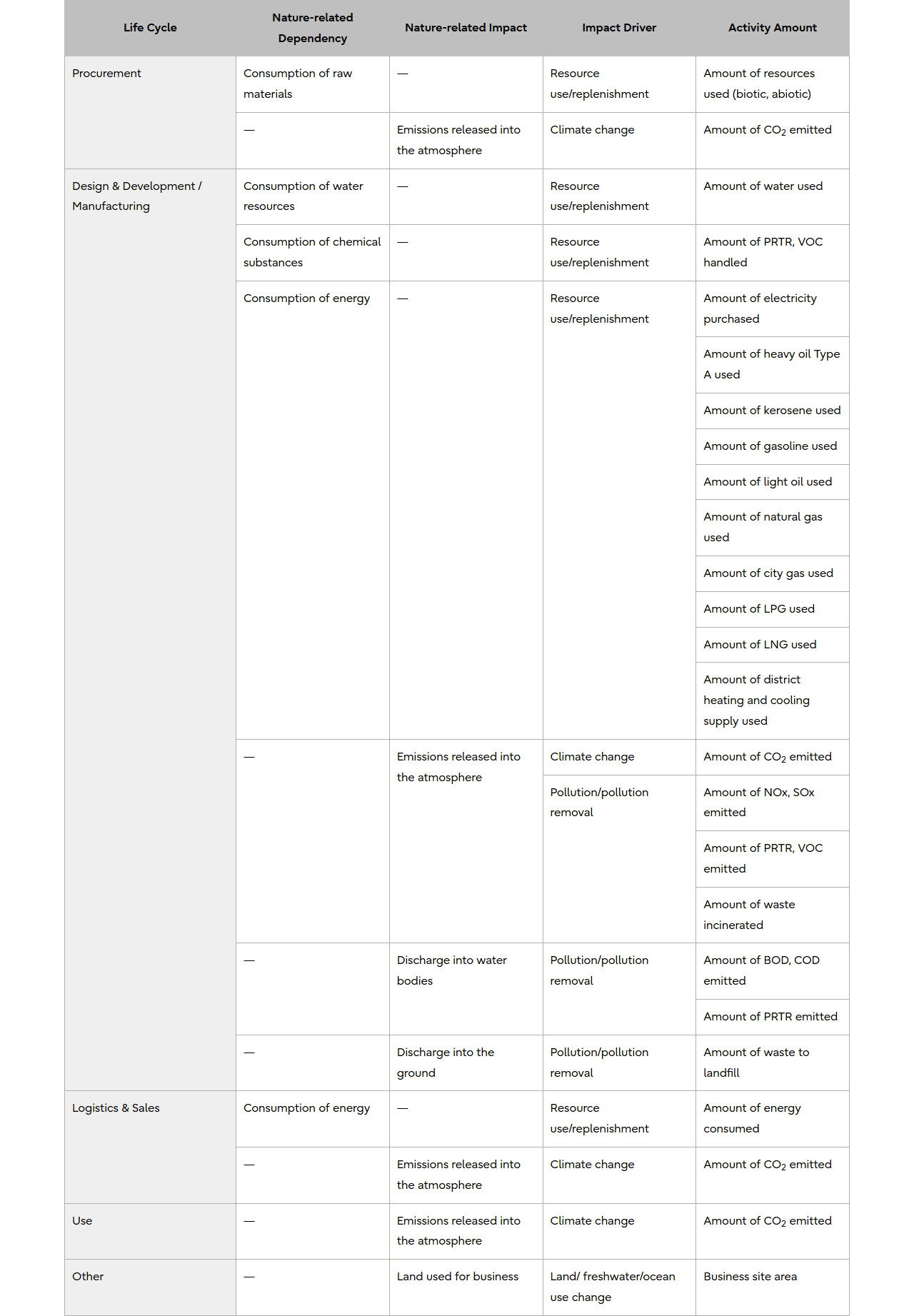
We then established an Ecological Footprint (EF) calculation method, using the above Activity Amount items as inputs. We used Life Cycle Inventory (LCI) data to convert some Activity Amount items (e.g., Amount of resources used) to Corporate Activity items that correspond to EF coefficients. Where a Corporate Activity item (e.g., Use of water resources) cannot directly use an EF coefficient, this is reflected in the EF calculation by using additional conversion logic based on scientific knowledge to expand on the original EF method.
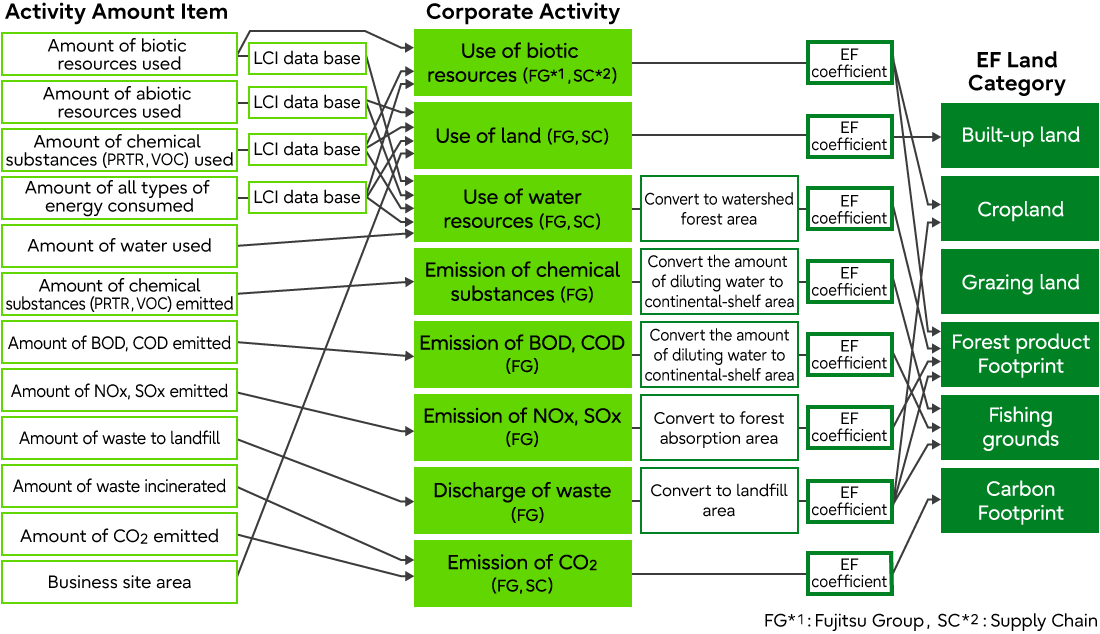
The results of our EF assessment of the Group's corporate activities show that Emission of CO₂ from the Group and its supply chain activities together account for 92% of the negative-impact factors. Water resource use accounts for the remaining 8%, but we found that this was mainly attributable to energy use. We established that Emission of CO₂ and energy use together account for 99% of the negative-impact factors. This means that activities aimed at reducing GHG emissions, such as energy conservation and the introduction of renewables, can also reduce our Ecological Footprint. In short, this clearly demonstrates that the Group’s climate change measures are proving effective in reducing negative impacts on biodiversity.
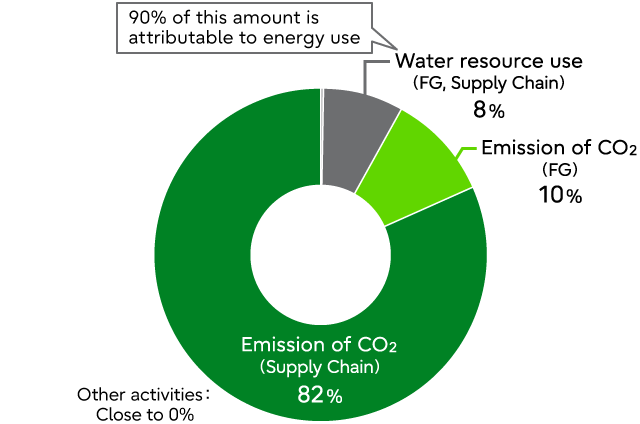
FY2024 Initiatives in Detail
28.5% reduction (FY2020 baseline) in negative impacts on biodiversity in the supply chain and locations in which the Group operates
As a result of using the Ecological Footprint as an indicator for assessing impacts in the supply chain and locations in which the Group operates, we have reduced the negative impact on biodiversity by 28.5% against a baseline of FY2020, thus achieving our FY2024 target of a reduction of at least 10% against a baseline of FY2020 (*2). This is due to a reduction in CO₂ emissions, notably a significant reduction in CO₂ emissions downstream in the supply chain (Scope 3 Category 11 emissions).
*2 EF coefficients are fixed for comparison
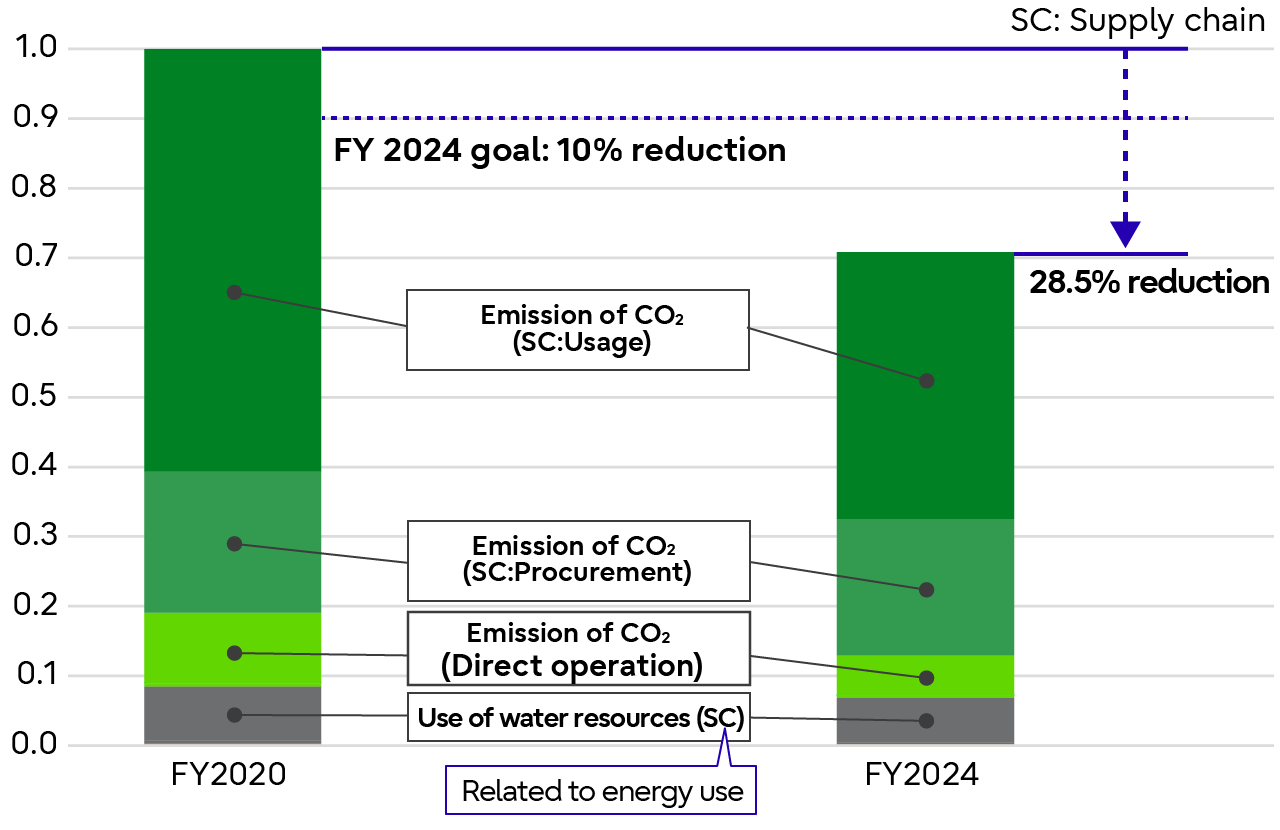
Continuous support of rainforest conservation in the Hutan Harapan (Forest of Hope) tropical rainforest in Sumatra, Indonesia
Since 2018, the Fujitsu Group has been supporting Hutan Harapan, a rainforest conservation effort on the island of Sumatra, Indonesia, through Birdlife International Tokyo. The Hutan Harapan rainforest is a massive forest of around 100,000 hectares (about half the size of Tokyo), located on the southern side of the island of Sumatra. This is the first area in Indonesia set aside as an Ecosystem Restoration Concession (Rights to use forests in a non-logging manner, such as the production of non-timber forest products), and rare animals such as the Sumatran tiger and Sumatran elephant still exist there. In addition to protecting the forest from threats such as forest fires and illegal logging, activities are underway to restore the original ecosystem of secondary forests that were previously commercially logged.
Currently forest patrols are being conducted as an urgent response to large-scale forest fires and illegal logging in the Hutan Harapan rainforest. However, because of the time and effort involved in conducting the patrols and aggregating information, those efforts restricted the resources available for the original mission of forest restoration. The Fujitsu Group has suggested digital technology use to support more efficient forest patrol activity. The use of digital technology has expanded the use of forest monitoring dashboards and new communications infrastructure, effectively countering the destruction of forest and contributing to its conservation.
For further details refer to Contributing to forest conservation through digital technology (*3).
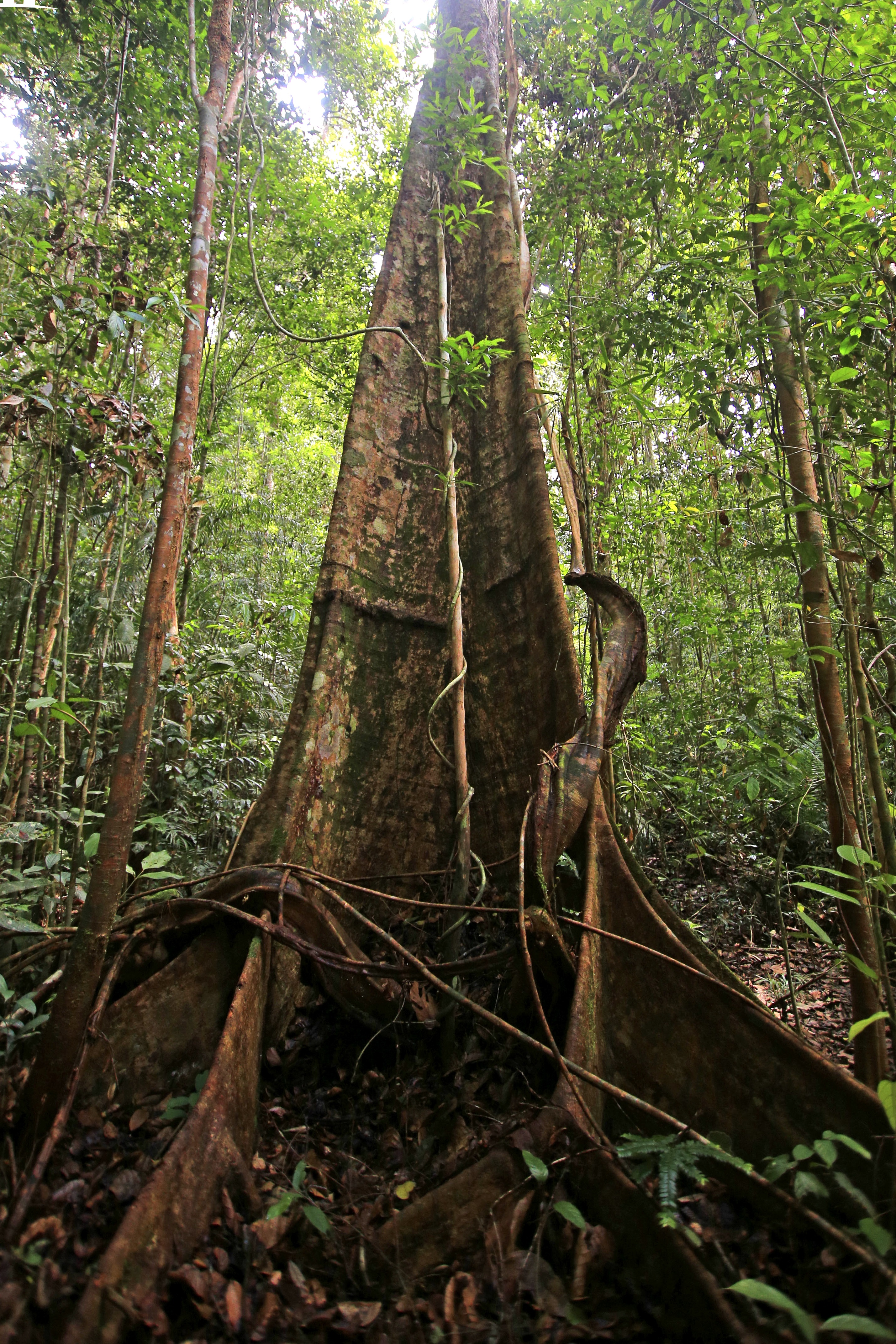
(Source:Hutan Harapan)
Related information
- Conservation of biodiversity


